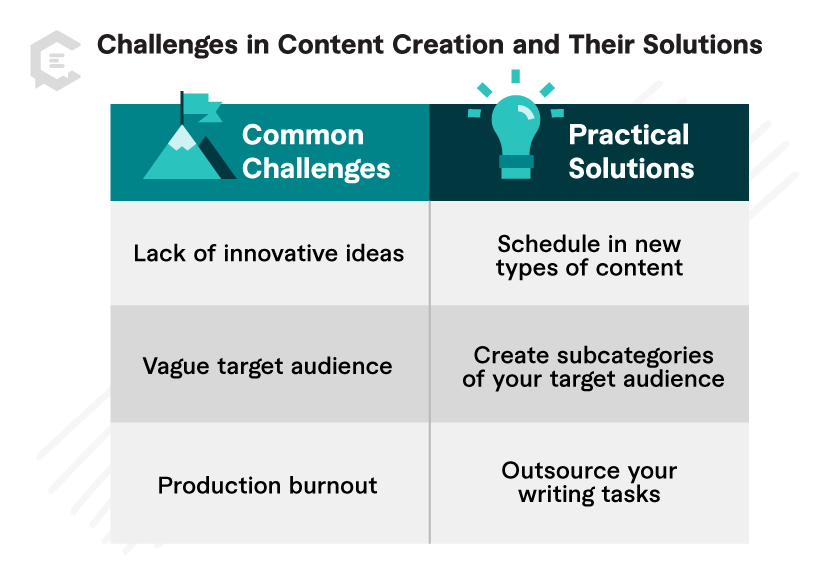The Role of Content Creation in Marketing
Think about the last time you searched the Internet for the answer to an important question. You probably skimmed through dozens of generic blog posts, social media links, and videos before finding an article or recording that taught you what you needed to know. Odds are you returned to that content creator’s website or channel the next time you needed an answer to a related question.
Despite the fact that any business owner can become a content creator by adding a blog to their website or posting videos on YouTube, not everyone crafts thoughtful media pieces that users consume on a regular basis. Those who do, however, become thought leaders in their industry and build a trustworthy brand for their company that attracts a steady stream of potential clients.
Thus, taking the time to establish a content creation process that lets you regularly produces high-quality content is an essential part of any marketing plan. In this article, we’ll examine the key steps to creating valuable content, the challenges of content creation, and practical tips for regularly creating high-quality content.
The Content Creation Process Explained
At its core, content creation is all about brainstorming ideas that appeal to your target audience and then exploring these ideas in mediums people enjoy getting their content from. This might mean writing a blog post, filming an instructional video, or interviewing an expert on your podcast.
Understanding the Importance of a Systematic Approach
While this may sound simple, content writers often feel stuck when developing good ideas for a blog or social media post. This wastes valuable time and can cost your company money since waiting for inspiration slows the content creation process.
Because of this, it’s important to develop content using a systematic approach that allows you to create valuable content on demand.
8 Steps to Creating Valuable Content
So, what steps do successful content creators follow to engage with their audience? We’ve broken down this process into a series of eight steps to help you not only develop content but also make it easy for your clients to find online.
Step 1. Understanding Your Audience
Before you write a single word, you need to understand the content that resonates with your target audience. Generate buyer personas of your ideal customers based on your company’s market segments. Study industry articles about consumers and ask your current customers to take online surveys about their needs.
For instance, the Sisters from AARP focuses on building an online community for Black women. This informs its site’s angles on health, wealth, relationships, and faith. Understanding its audience’s needs allowed the Sisters of AARP to win a Content Marketing Award for its exceptional content.
Step 2. Ideation & Keyword Research
Look at the questions your target customers are asking online. If they’re wondering how B2B companies can attract better leads, perhaps a blog post on “4 Excellent Lead Generation Strategies for B2B Marketers” will engage your readers.
Study the keywords and phrases users are typing into search engines to find answers to their questions. You can make your content more visible in online searches by using target keywords in your headlines, subheadings, and copy.
Step 3. Structuring Your Content
Structured content involves breaking down your content into individual parts to make it easier to organize and produce.
For instance, a blog post’s headline, keyword tags, image, introduction, and subheadings are all component elements of the overall post. Knowing that you need all these elements for your blog posts before you start writing helps you outline each post and assemble all the required components faster.
Structuring your content also makes it easier to repurpose your existing content. For example, you could turn a webinar into a blog post, a video script, and a slide presentation by identifying and reusing key components. This lets you quickly generate more content across multiple platforms, reaching a larger audience.
Step 4: Hiring Content Creators
When hiring content creators, you can assemble a team of copywriters and designers completely in-house or outsource a group of freelancers you can use on an as-needed basis. Both have advantages and disadvantages, but you should decide based on your marketing needs and budget.
While an in-house team may better grasp your business brand and marketing goals, hiring freelancers for key projects can be less expensive. Finding reputable freelancers with relevant experience is also a challenge, but this can be overcome by hiring through a content agency like ClearVoice that vets all freelancers, ensuring you only work with experts.
When communicating your goals to your content creators, be sure to create detailed content briefs highlighting the type of audience you’re targeting and the type of language you want to use in your content. Supply sample outlines of your blog posts, infographics, scripts, etc., so your content creators know how to structure your material.
Step 5. Incorporating the Visuals
Adding visuals to written content attracts attention from audiences and draws attention to key points. For instance, online glasses retailer Warby Parker’s marketing emails make minimum use of copy while spotlighting images of their eyewear. This makes it easier for readers to spot their calls to action and the company’s contact information while still focusing on its merchandise.
Illustrate complex concepts by including an infographic or video with your blog post or article. When incorporating visuals into your content, be sure to select high-resolution images that increase audience engagement. Be sure to also follow any copyright guidelines and restrictions.
Step 6. Editing and Proofreading
Ensure your final draft is free of spelling, grammar, or punctuation errors. Reread your content to spot any awkward phrasing or sentence structure issues. Catching and fixing these errors early lets you produce more high-quality content.
Step 7. SEO Optimization
Search engine optimization (SEO) strategies maximize the number of visitors to your company website by ensuring your site and its content appear high on a search engine results page (SERP). You can do this by:
- Including keywords your target audience uses in their online searches within your headlines, subheadings, and copy.
- Publishing helpful, original content on a regular basis
- Including images and videos with your written content
- Keeping your content free of grammatical and spelling errors
Step 8. Promotion & Distribution
No matter how well-written your content is, getting people to consume it requires both promotion and distribution.
Promoting your content involves advertising your content to a broad group of people. One way to do this is by launching a paid promotion campaign that showcases your site and its content on the social media sites your target audience frequents.
Distributing your content means delivering your content to an established audience. Sharing your content with your existing social media following is a form of distribution. So is sharing links to your articles and blog posts with your email newsletter subscribers.
Overcoming Challenges in Content Creation
While the systemic approach covered above will help you produce high-quality content, you’ll still face many challenges in the content creation process. Knowing the issues you must contend with will help you prepare for them.
Identifying Common Challenges
Often, the challenges faced by content creators sneak up on them over time, yet tend to take the same forms, including:
- Lack of innovative ideas: Constantly producing the same type of content or failing to explore new topics can keep your audience from engaging with your content.
- Vague target audience: Trying to appeal to an extremely broad audience or focusing on a very narrow segment of consumers keeps you from connecting with your ideal clients.
- Production burnout: Producing well-written content on a regular basis is taxing and can drain your copywriters creatively and physically.
Practical Solutions for Overcoming These Challenges
So, what can you do to overcome these content creation challenges? Try incorporating the following into your business strategies:
- Schedule in new types of content: Allocate time in your schedule to experiment with different types of content. Try creating infographics or videos if you’ve only produced blog posts so far. If your audience responds well, start producing this content regularly.
- Create subcategories of your target audience: Produce content dealing with broad topics and then craft more specific content designed to appeal to segments of your audience. You’ll learn more about your target audience’s needs by tracking the content that converts the most readers with analytic tools like Google Analytics.
- Outsource your writing tasks: If your marketing team needs more support, outsource writing tasks to a content agency like ClearVoice. Your in-house team can ensure the content produced matches your company’s brand image and message.
Conclusion: Create High-Value Content for Your Business
Creating valuable content that builds your brand and attracts your target audience is challenging, but by adopting a systematic approach to content creation, you can produce such content regularly.
Make sure to clearly understand your audience’s needs to focus your brainstorming sessions. Create structured content to speed up your writing and editing process. Make sure to select eye-catching visuals and optimize your content for SEO. To ensure your content is consumed, promote it to a wide audience and distribute it to an established following.
Remember: content creation is a fluid process. Even if your current approach works for you now, you will still encounter additional challenges in the future. Because of this, keep learning about new content creation strategies. Make participating in online courses like HubSpot Academy’s free Content Marketing course a regular part of team activities. As your business grows, the tactics you use to produce your content will change, requiring you to take advantage of the opportunities that present themselves.
For help with creating stand-out content, see how ClearVoice’s network of vetted freelancers makes generating high-quality content easier and eases the challenges faced by your company. Get started with ClearVoice today and find the right marketing copywriter for your business.






